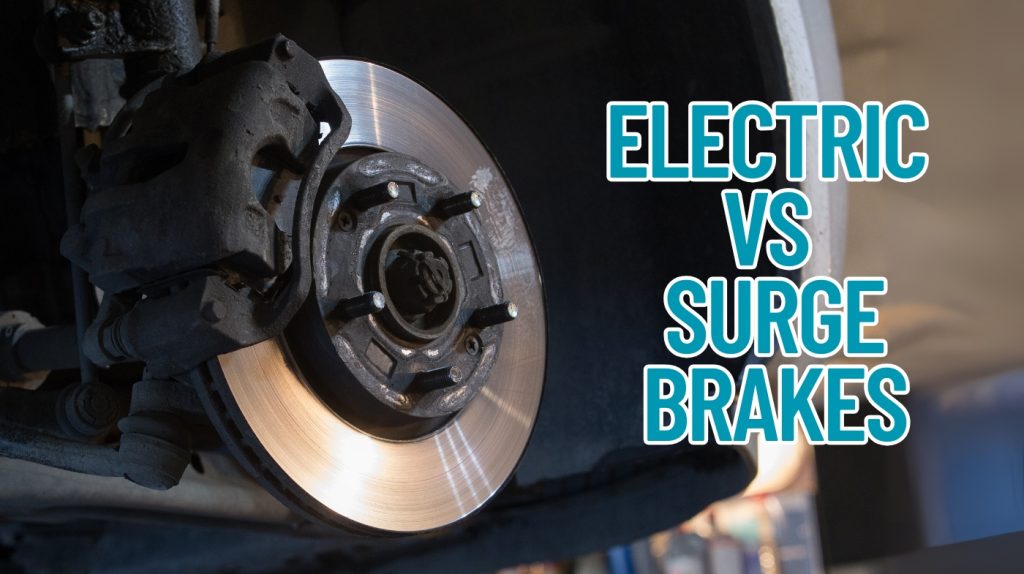Last Updated on June 28, 2025
You’ll find electric brakes use electromagnetic forces, activating instantly via electrical current for precise control and quick response, ideal for heavier loads and complex driving conditions.
Surge brakes rely on trailer momentum to hydraulically engage, causing slight activation delays but offering mechanical simplicity and cost-effectiveness, suited for lighter trailers.
Both require maintenance, yet electric brakes enhance safety with override options and integration. Understanding these differences clarifies which system fits your towing needs best and why.
- Self-Adjusting Electric Brake: Say goodbye to manual adjustments! Dive into the world of 12″ x 2″…
- Hassle-Free Installation: DIY’s best friend! Our electric trailer brake is straightforward and a…
- Built for the Long Haul: Keep on rolling! With a lifespan of up to 30,000 kilometers, these trailer…
- Rated Capacity: 7,000 pounds
- Use for Hydraulic Drum Surge Brakes
- Ball Size: 2″
Key Takeaways
- Electric brakes use electromagnetic force controlled by electrical current for instant, precise braking; surge brakes engage hydraulically via trailer momentum with slight delay.
- Electric brakes offer manual control and in-cab modulation for stability and safety, while surge brakes activate automatically based on trailer inertia without driver input.
- Surge brakes are simpler and cheaper to install, ideal for lighter trailers and moderate speeds; electric brakes require wiring and controllers but provide better performance for heavy loads.
- Electric brakes include break-away safety systems and enable quick response to sway or instability; surge brakes lack fine control and driver override capabilities.
- Both systems need regular maintenance, but electric brakes require more frequent inspections and adjustments to maintain optimal responsiveness and safety.
Comparison Table Between Electric Brakes and Surge Brakes
| Feature | Electric Brakes | Surge Brakes |
|---|---|---|
| Response Time | Instant activation via electrical signal | 1-second delay due to momentum dependency |
| Control Type | Manual control with in-cab brake controller | Automatic activation based on trailer inertia |
| Installation | Complex – requires wiring and controller | Simple – mechanical/hydraulic components only |
| Initial Cost | Higher due to controller and installation | Lower with minimal labor requirements |
| Best For | Heavy loads and precise control needs | Light trailers and simple setups |
| Maintenance | Annual inspections every 12,000 miles | Annual inspections focusing on hydraulic fluid |
| Safety Features | Break-away system and manual override | Fail-safe reliability without electrical dependency |
| Power Dependency | Requires electrical connection | No electrical connection needed |
How Electric and Surge Brakes Work?
Although electric and surge brakes serve the same purpose of slowing trailer wheels, they operate through fundamentally different mechanisms:
Electric brakes use Electromagnetic forces controlled by electrical current from the towing vehicle, while surge brakes rely on the trailer’s momentum to mechanically or hydraulically activate braking without any electrical input. Understanding these differences is crucial for ensuring emergency preparedness during towing.
In electric brakes, an energized brake magnet is attracted to the drum surface, generating friction proportional to the current supplied by the brake controller. This magnetic torque opposes wheel rotation, increasing with speed and automatically disengaging when power is cut.
The brake magnet is housed within a backing plate that is bolted to the brake flange behind the spindle, ensuring proper mechanical connection and function backing plate installation.
Conversely, surge brakes engage via a hydraulic or mechanical actuator compressed by trailer inertia pushing forward during deceleration, which pressurizes brake fluid or activates mechanical linkages.
This self-contained system modulates braking force directly from trailer momentum, requiring no external control or wiring. Proper maintenance and regular inspection of these components are essential to maintain reliable function and safety.
Comparing Braking Performance and Control
You’ll notice electric brakes respond faster by activating instantly through an electrical signal, allowing precise modulation of braking force. This instant response can be compared to the efficiency of enzyme-based formulations in RV tank treatments, which act quickly and effectively.
Surge brakes, on the other hand, rely on mechanical momentum, which introduces a slight delay but offers natural proportional control without electronic input.
Understanding these differences helps you evaluate the benefits of manual adjustment versus automatic responsiveness for your specific towing needs. Surge brakes provide a self-activating system that adjusts braking pressure based on the trailer’s load and deceleration without the need for external wiring or controllers.
Responsiveness and Precision
When evaluating braking systems, responsiveness and precision critically influence safety and control during towing. Electric brakes engage almost instantly when you press the brake pedal, transmitting signals within milliseconds for immediate trailer brake activation.
This near-zero lag enhances your ability to perform quick, controlled stops. Their effectiveness can be further enhanced when combined with load capacity matched components to ensure consistent braking performance.
Additionally, you can adjust braking force precisely via an in-cab controller, ensuring consistent performance across varying loads and road conditions. This ability to dial in braking force allows for better customization compared to surge brakes.
In contrast, surge brakes rely on physical pressure as the trailer pushes against the coupler, causing an inherent activation delay that can reach up to a second. This lag reduces responsiveness, especially in emergency stops, and performance can vary with slippery surfaces or trailer alignment.
While surge brakes self-adjust proportionally to load, they lack the direct, precise modulation electric brakes provide, impacting your control in rapidly changing scenarios.
Manual Control Benefits
Since electric brakes let you manually adjust braking force via an in-cabin controller, you gain precise control over trailer braking performance tailored to load and road conditions. This manual adjustability enables you to fine-tune timing, sensitivity, and braking intensity using time-delayed, inertia-based, or proportional systems, optimizing stability on hills, curves, or windy roads.
Unlike surge brakes, which rely solely on hydraulic pressure generated by trailer momentum and lack real-time driver override, electric brakes let you counteract sway or trailer instability instantly. This capability reduces jackknifing risk and improves safety during dynamic driving.
Additionally, manual control allows adaptation to varying loads, minimizing brake wear and maximizing effectiveness. Overall, electric brakes provide nuanced, responsive control that enhances towing stability and safety beyond the fixed, momentum-dependent function of surge brakes.
Furthermore, integrating electric brakes with systems that include a Battery Management System ensures safer and more reliable power supply during operation.
Installation and Cost Differences
Although surge brakes simplify installation by relying solely on mechanical and hydraulic components on the trailer, electric brakes demand additional setup inside the tow vehicle, including wiring and a brake controller.
Surge systems mount a hydraulic actuator and connect brake lines, while electric systems require wiring, controller installation, and precise calibration. Cost-wise, surge brakes usually incur lower initial labor costs but may demand pricier hydraulic repairs.
Electric brakes have higher upfront costs due to controller purchase and installation but offer adjustable braking control. However, surge brakes do not allow independent control over trailer braking, which can limit braking precision compared to electric systems.
Proper installation complexity assessment is essential to ensure safety and performance when choosing between the two brake types.
Ideal Use Cases for Each Brake Type
Because braking demands vary considerably across vehicle types and applications, selecting the appropriate brake system hinges on specific operational requirements.
You’ll find electric brakes ideal for electric and hybrid vehicles, industrial machinery, and any application requiring rapid response and precise control. They integrate well with electronic systems, offer adjustable stopping power, and reduce environmental impact due to less brake dust.
Additionally, electric brakes often include regenerative braking, which helps recharge batteries and reduce brake wear. Their performance can be further optimized by monitoring battery health to ensure consistent power supply and braking efficiency.
Conversely, surge brakes suit trailers especially recreational or cargo types where mechanical simplicity is preferred, and electrical hookups are impractical. They activate via trailer inertia, making them effective for moderate speeds and frequent stops without requiring electronic controls.
Ultimately, if your use case demands sophisticated modulation and integration, electric brakes are superior; if you need straightforward, reliable trailer braking without complex electronics, surge brakes are the practical choice.
Maintenance Requirements and Durability
When you maintain electric and surge brakes properly, you extend their service life and guarantee reliable performance. Electric brakes demand annual inspections or every 12,000 miles, with initial shoe and drum adjustments after 200 miles.
You must clean components like magnets and brake shoes regularly to prevent performance loss. Surge brakes also require annual inspections, focusing on hydraulic fluid levels, brake wear, and actuator function. Their hydraulic systems need vigilance to avoid leaks and maintain pressure.
Durability-wise, electric brakes’ electronic parts require careful environmental protection, while surge brakes’ hydraulic actuators face wear-related replacements.
Both systems’ longevity hinges on consistent, precise adjustments and component care, ensuring balanced braking and operational integrity. Regular maintenance, similar to how RV awning cleaners protect awning materials, helps prevent premature wear and keeps braking systems functioning optimally.
Safety Features and Driver Experience
You’ll notice electric brakes give you independent control over trailer braking, letting you adjust force precisely from the cab. This responsiveness enhances stability during emergency maneuvers by providing consistent, balanced braking.
Additionally, electric brakes often feature a break-away safety system that activates brakes if the trailer becomes detached, adding an important layer of security.
Surge brakes react automatically to momentum but lack this fine-tuned control, which can affect handling under sudden stops. Proper brake maintenance is essential for both systems to ensure reliable operation and safety.
Independent Trailer Brake Control
Although towing heavy loads can challenge vehicle stability, independent trailer brake control systems give you precise command over trailer braking separate from the towing vehicle.
These systems enable manual or automatic modulation of trailer brake force, enhancing safety on descents and under varying load conditions. This control is especially crucial when towing trailers equipped with electric brake systems, which require consistent power to maintain optimal performance.
Trailer Safety Control (TSC) uses wheel speed sensors to detect sway or slip, applying brakes selectively to stabilize the trailer. Advanced controllers integrate diagnostics and odometer data, optimizing braking response while alerting you to potential issues.
Breakaway switches and ABS prevent detachment-related accidents and wheel lock-ups, reducing jackknifing risks. Many states legally require trailer brakes for trailers over 1,500 pounds, emphasizing the importance of brake system regulations.
Braking Responsiveness Comparison
Because braking responsiveness directly affects towing safety and driver confidence, understanding the differences between electric and surge brakes is essential.
Electric brakes offer precise control through an in-cab brake controller, letting you adjust timing and sensitivity to match trailer weight and road conditions. This responsiveness ensures quicker, consistent activation synchronized with your vehicle’s brakes.
In contrast, surge brakes activate hydraulically based on inertia, causing a slight delay, especially in rapid stops. Their braking force adapts automatically but less precisely, potentially resulting in uneven or abrupt stops.
Additionally, surge brakes’ responsiveness can degrade with hydraulic fluid issues, while electric systems maintain consistency and can alert you to performance problems. Choosing a braking system with reliable shock absorbency helps maintain control and enhances overall safety during towing.
Stability During Emergency Maneuvers
Having a responsive braking system is critical, but maintaining stability during emergency maneuvers directly influences safety and driver confidence. Electric brakes provide precise modulation through an in-cab controller, allowing you to adjust braking force dynamically.
This fine control helps prevent trailer sway and enhances stability during abrupt stops. In contrast, surge brakes rely on trailer momentum to activate hydraulics, offering smooth but less adjustable braking. This can cause delayed response and less consistent control, potentially compromising stability in sudden maneuvers.
Additionally, surge brakes are particularly well-suited for boat and marine trailers due to their water resistance. However, surge brakes excel in fail-safe reliability without electrical dependency, maintaining braking power even during power loss.
Choosing the Right Braking System for Your Trailer
When selecting the right braking system for your trailer, you must weigh factors like load weight, braking control needs, and tow vehicle compatibility.
Surge brakes suit lighter trailers and simpler setups, leveraging hydraulic force without electrical dependency, making them cost-effective and easy to install. However, their braking force is momentum-dependent and less adjustable. Additionally, surge brakes require hydraulic system maintenance to prevent corrosion and ensure proper function.
Electric brakes, controlled via a brake controller, provide precise modulation, essential for heavier loads or variable conditions like steep descents or sway control. They require electrical integration and higher upfront costs but offer superior responsiveness and safety.
Evaluate your trailer’s weight, backup requirements, and tow vehicle’s electrical capacity. If you prioritize fine-tuned braking and operate in challenging environments, electric brakes are preferable. For straightforward use and minimal maintenance, surge brakes remain viable.
Frequently Asked Questions
Can Electric Brakes Be Used on Trailers Without Electrical Systems?
You can’t use electric brakes on trailers without electrical systems because they depend entirely on electrical signals to engage. Without wiring or a brake controller, the brakes won’t activate.
You’d need to install wiring harnesses and a compatible brake controller in your tow vehicle or on the trailer itself. While electric brakes offer precise control, they require a reliable electrical connection, which trailers lacking systems simply don’t have by default.
Are Surge Brakes Affected by Extreme Cold Weather?
Yes, surge brakes are vulnerable in extreme cold. The hydraulic fluid can thicken or freeze, reducing pressure and braking efficiency. Moisture inside brake components can freeze, causing sticking or locking.
Brake lines may crack, letting in water that worsens freezing risks. You’ll need frequent inspections and maintenance to prevent damage. Using antifreeze fluids and avoiding moisture ingress are critical to keep surge brakes reliable in freezing conditions.
How Do Electric Brake Controllers Sync With Vehicle ABS Systems?
Imagine syncing a telegraph with a modern smartphone electric brake controllers use triple-axis accelerometers to detect your vehicle’s motion, sending precise proportional brake signals. They communicate via vehicle-specific wiring harnesses to your ABS system, ensuring brake modulation adapts seamlessly.
This coordination prevents trailer wheel lockup by adjusting brake pressure in real-time, complementing ABS interventions. You get enhanced stability and safety through continuous calibration that aligns trailer braking with your vehicle’s anti-lock behavior.
Can Surge Brakes Cause Wear on the Tow Vehicle’s Hitch?
Yes, surge brakes can cause wear on your tow vehicle’s hitch. The actuator slides during braking, creating repeated mechanical movement that stresses the hitch components.
Over time, this sliding motion can lead to increased wear and potential damage, especially if the actuator isn’t properly adjusted or the hitch isn’t well-lubricated. Regular maintenance and inspection are vital to mitigate this wear and ensure safe, smooth operation of your towing setup.
What Are the Signs of Failing Electric Brake Magnets?
You’ll notice erratic brake engagement, like inconsistent grabbing or releasing, signaling magnet issues. Listen for unusual grinding or scraping noises that indicate poor magnet-to-drum contact. Visually inspect for exposed windings, frayed wires, or corroded magnet surfaces.
Measure electrical resistance with a multimeter; values outside the specified range or an open line reading confirm magnet faults. Reduced braking intensity despite controller settings also points to worn or misaligned magnets needing replacement.
Maintenance Made Easy: Keeping Your Braking System Reliable
Choosing between electric and surge brakes is like selecting the right compass for your journey; each guides your trailer safely but in distinct ways. Electric brakes offer precise, responsive control, acting like a digital navigator, while surge brakes provide mechanical reliability, akin to a steadfast anchor.
Understanding their performance, installation, and maintenance helps you steer confidently, ensuring your trailer’s braking system aligns perfectly with your specific needs and driving conditions.
- Premium Material: This brake drum is made of high-quality iron and uses electroplating technology to…
- About The Drum and Self-Adjusting Electric Brakes: Classic design and rich production experience…
- Package Including: 2*brake drum 5 hole, 4.5″ bolt, 2*Bearing inner ring replace for L68149(…
- Series 82401 660 brake actuators
- Style drum brake ready
- Material aluminum master cylinder is corrosion-resistant
Last update on 2025-11-22 / Affiliate links / Images from Amazon Product Advertising API







